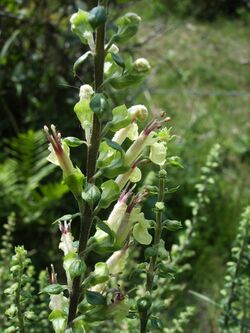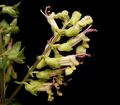Biology:Teucrium scorodonia
| Teucrium scorodonia | |
|---|---|

| |
| Scientific classification | |
| Kingdom: | Plantae |
| Clade: | Tracheophytes |
| Clade: | Angiosperms |
| Clade: | Eudicots |
| Clade: | Asterids |
| Order: | Lamiales |
| Family: | Lamiaceae |
| Genus: | Teucrium |
| Species: | T. scorodonia
|
| Binomial name | |
| Teucrium scorodonia | |
Teucrium scorodonia, common name the woodland germander[1] or wood sage, is a species of flowering plant in the genus Teucrium of the family Lamiaceae. It is native to Western Europe and Tunisia, but cultivated in many places as an ornamental plant in gardens, and naturalized in several regions (New Zealand, Azores, and a few locales in North America).[2][3]
Description
Teucrium scorodonia reaches on average 30–60 centimetres (12–24 in) of height. It is a hairy herbaceous perennial with erect and branched stems. The leaves are petiolate, irregularly toothed, triangular-ovate to oblong shaped, lightly wrinkled. The inflorescence is composed by one-sided (all flowers "look" at the same side) pale green or yellowish flowers bearing four stamens with reddish or violet filaments. These flowers grow in the axils of the upper leaves and are hermaphrodite, tomentose and bilabiate but lack an upper lip, as all Teucrium ones. The flowering period extends from June through August. These plants are mainly pollinated by Hymenoptera species.
Subspecies
- Teucrium scorodonia subsp. baeticum (Boiss. & Reut.) Tutin
- Teucrium scorodonia subsp. euganeum (Vis.) Arcang
Habitat
These plants prefer sandy soils in woodland and acid heaths, at an altitude of 0–1,500 metres (0–4,921 ft) above sea level.
Gallery
References
- Pignatti S. - Flora d'Italia - Edagricole – 1982 Vol. II, pg. 443
- {{citation
| mode = cs1 | title = Teucrium scorodonia | work = Germplasm Resources Information Network (GRIN) | url = | publisher = [[Organization:Agricultural Research ServAgricultural Research Service (ARS), United States Department of Agriculture (USDA) | access-date = }}
External links
Wikidata ☰ Q161748 entry
 |






